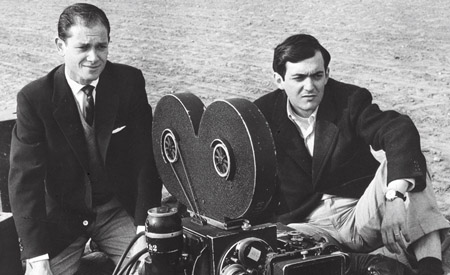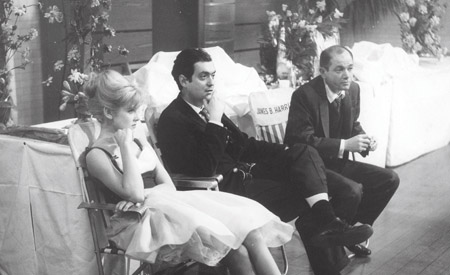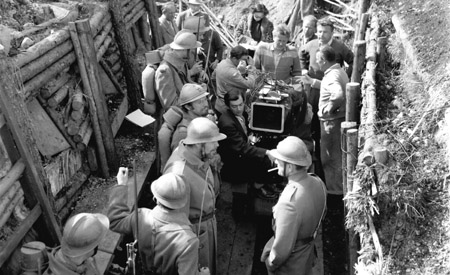By F.X. Feeney
 HORSE SENSE: The racetrack heist movie The Killing was the first film Kubrick (right) and Harris made together. “Stanley pretty much knew in his guts what he wanted to do, and then did it.”
HORSE SENSE: The racetrack heist movie The Killing was the first film Kubrick (right) and Harris made together. “Stanley pretty much knew in his guts what he wanted to do, and then did it.” You'll never know complete satisfaction until you’ve tried your hand at directing,” Stanley Kubrick told his close friend and producer James B. Harris one day, late in 1962. The pair had been creative partners for nearly a decade--working together on a string of critically successful pictures: The Killing (1956), Paths of Glory (1957) and Lolita (1962).
After Lolita gave them both a welcome financial independence, they collaborated on a nuclear war-themed thriller called Edge of Doom, only to find they were at an amiable deadlock over the tone of the picture. Harris was committed to straightforward suspense; Kubrick wanted to turn it into an absurdist comedy. (It was later made as Dr. Strangelove or: How I Learned to Stop Worrying and Love the Bomb.) “I’m about to become the worst kind of producer,” Harris warned him, “I’m about to try and tell you how to direct your picture.” Kubrick replied: “You should direct.” On that note they dissolved their partnership but remained friends for life, until Kubrick’s death in 1999. And Harris went on to direct five features including The Bedford Incident (1965) and Some Call It Loving (1973).
In a sense, Harris taught Kubrick how to produce, and Kubrick taught Harris how to direct. Artifacts, letters, scripts, photographs from their partnership, are currently on view as part of the Stanley Kubrick exhibition at the Los Angeles County Museum of Art. In a conversation with the Quarterly, Harris shares a rare view of Kubrick’s working method.
Q: Kubrick showed you his second film, Killer’s Kiss (1955), early on in your friendship. What appealed to you as a prospective producer?
A: What impressed me was that he’d completed it. In those days, you’d hear somebody was making a film, and making a film, but never see the film. What happened? They got halfway through and ran out of money, or it didn’t work. Stanley completed his film. He shot the picture with a wild track; he had to lip-sync everything in postproduction. That was intensive, precision work back then. I was very impressed. I had access to funding, and so proposed a partnership.
I came across Clean Break, by Lionel White; a fast-paced novel about a racetrack robbery shown from many points of view. It was a terrific story. Stanley read it the day after I did and agreed that it was great for us. Stanley wrote the screenplay and Jim Thompson contributed some dialogue; we called it The Killing. We were determined to keep the offbeat time-structure from White’s book.
Q: How did that play for a 1950s audience?
A: There were walkouts at the preview. People didn’t know what they were going to see, and were confused. Sterling Hayden’s agent told us we’d wrecked the picture. Even friends advised us to make it more conventional. Stanley and I asked ourselves, ‘Have we blown it?’ We rented an editing room and built a linear cut of the picture. Halfway through screening it for ourselves, we looked at each other and said, ‘This stinks. Let’s put it back the way we had it.’
You’ve got to believe in your own instincts. If you listen to hostile voices, even those of friends, you shouldn’t make movies. If you’re going to fail, fail with your own contributions, not somebody else’s. Lesson learned!
Q: Can you describe a typical day--if there was such a thing as a typical day--shooting Paths of Glory?
A: The battlefield scenes were the last things on the schedule. That farmland we hired had to be dressed and built into a battlefield, with the trenches and barbwires and all of the shell holes. Stanley loved moving shots.
The main thing was taking Kirk [Douglas] through this obstacle course, this barrage. The idea was that Kirk was going to be followed, in a moving shot, through as much action as we could muster before a cut had to be made, after which we would set up to continue. It was cold; it was uncomfortable; it was wet. Everything was tough on Kirk. After he did it the first time, he told Stanley, ‘I’ll give you one more, maybe two, but that’s it. I’m not going to do this forever.’ I remember Stanley asked me to go up on one of the big parallels, to check out an angle.
Q: A parallel meaning a crane?
A: No. A parallel being a platform we built. Stanley didn’t like heights. I climbed up to look through the camera, and saw the image we were going to get. We had multiple cameras, even a handheld in the middle of the field, to cover the explosions, while Stanley covered Kirk with the moving shots.
I don’t remember Stanley ever coming in with homework, saying, ‘This is the first shot we’re going to do.’ He pretty much knew in his guts, and then did it. Then again, there’s no room in a scene like that for added ideas. It’s a done deal: show Kirk going through the battle. Make it look as uncomfortable and dangerous as it can possibly look, with explosions all around him. Kirk had to crawl through the cold water and muddy shell holes.
Q: You worked side by side every day with Kubrick for close to ten years. What was that like day-to-day?
A: I was required by Stanley to be there, not just as a producer, but because he liked input. There was no insecurity about him. Some people who are insecure don’t want other people hanging around, because they don’t want them to see, or witness any indecision on their part, or anything that could indicate they’re not sure of what they’re doing. Openness to suggestion was one of Stanley’s great attributes. He genuinely thought any idea that was better than his was going to make the picture better.
Q: How did Kubrick deal with conflicts on the set? Did he raise his voice?
A: No. Stanley would never--not ever in the three pictures we did together--lose his temper. I don’t know if that changed after we went our separate ways. When we were together he was always able to outlast the other side of the argument, whether with actors, or in the case of Lucien Ballard on The Killing, the DP. On the first day of principal photography, Ballard, by then very established and sought after, decided to lay a set of tracks and choose a lens contrary to what had been asked for. When Stanley discovered this, he repeated his first order. Ballard objected, ‘It’ll be fine like this. Nobody will notice.’ Stanley looked him in the eye and said quietly, ‘You will either do as I direct or you can leave right now.’ Ballard nodded, rebuilt the tracks and they never had another bad moment.
Stanley would say to me, ‘You need to write things down.’ He always had a notebook with him. He’d talk to somebody on the crew, ask them about the progress of this or that, and then jot a note. Later we’d be walking down the hall, and if this person were coming at us the other way, Stanley would already be patting his pocket, ready to follow-up. That was a moment of panic for a few people. You could see it in their eyes when they had no answer.
We shot The Killing in 24 days; Paths of Glory in 66 days. We were getting up there, but disciplined. If I had to say to him, ‘We’re two days behind schedule,’ he’d smile and say: ‘Oh yeah? Watch this,’ and wham! We’d be back on.
Q: How would he do that?
A: He was fast on his feet, and would think through a way to cover whatever was next--either simply, or in a single complex master.

DOWN AND DIRTY: (above) The success of Lolita, starring Sue Lyon, gave Kubrick and Harris financial independence. (below) Kubrick (seated center) loved tracking shots in the trenches for Paths of Glory.

Q: What was the hardest part about directing for Kubrick?
A: Stanley would always say it was ‘the moment you arrive on the set each morning.’ It’s that way for every director. It was no different for Kubrick. You’ve got a city block filled with equipment, trucks, extras in costume, honeywagons. There you are pulling up, and dozens if not hundreds of people are looking straight at you. They’ve all got questions, and they need them answered right away. Everybody likes the idea of being a director--of being that guy that everybody looks to--but the reality is a whole other ballgame. You’ve got to be ready to answer, but you’ve got to keep your nerve and not answer too fast.
They talk now about how Kubrick disciplined himself with chess. It’s true. You’re staring at the board and you think, ‘I can grab that guy’s queen,’ but if you don’t catch your breath and rethink, you could be building a trap for yourself. The same with filmmaking: You don’t want to be too attracted to an easy answer. An idea might look great on the surface, but create a world of problems up the line. And that applies if you’re in a bad spot. If some disaster happens, and everything’s capsized--keep your nerve. Don’t jump at the first easy answer. Look at your options. They’re there.
Q: Kubrick clearly knew what he wanted to do. Would he listen to other opinions?
A: Stanley had a very open mind. He encouraged contributions by other people. A number of suggestions I made, he accepted, but if he didn’t like them, you weren’t criticized. He admired you; he admired anybody who thought enough about something to have an idea, with the intention of making it better. He’d say, ‘Look. The director’s going to get credit for everything in the picture, no matter where the idea comes from. If a lighting guy on the catwalk yells down, ‘Why don’t you try it from this angle,’ and that suggestion is better than the idea you had, you’re going to get the credit for it anyway. Why not accept it?’ [laughs]
If an idea makes a picture better, pride of authorship is a waste of time and effort. Kubrick invited enormous input from me on Lolita. My brother, Bob, composed the ‘Love Theme,’ which Stanley loved. I picked Nelson Riddle to do the score. The first day we came to record the theme, we discovered that Nelson had written it in a minor key. As soon as he started to play it, I jumped out of my seat. ‘We can’t do this in a minor key. A minor key works if you’re doing horror, or suspense, but we don’t want that. The main love theme should be beautiful.’ Stanley welcomed that adjustment. He appreciated that I could discern a difference, and let me run with what I could contribute to the film. So, overnight it was transposed into a major key, and became something else entirely.
Q: After you parted ways and began directing for yourself, did he give you advice?
A: He not only gave me advice, he wrote down things for me like I was a kid he was sending to school. ‘Don’t get bullied into making a shot-list’ was key advice. He said, ‘A lot of magic happens on the set; it’s no disgrace to not know what you want to do.” It’s no disgrace. If you’re not careful, people will bully you into thinking there’s something wrong with you if you don’t have a clear image of where every shot is, and where you’re going to put the camera. Stanley said, ‘It’s much better to discover your strategy with dialogue scenes. You want the actors to make a contribution. Don’t put them in a position where they’re told what to do--that you’ve already set up the first shot in your mind. They may feel more comfortable walking around, doing this or that.’ He often said: ‘Let the camera accommodate the actors. Don’t have the actors accommodate the camera.
Q: What did you learn about casting from Kubrick?
A: He always drilled into my head that you live or die by your choice of actors. They can be brilliant and bring to your film a dimension beyond your highest expectations. But they can also be incompetent, irresponsible, subject to moods, insecure, and the bearer of unlimited personal problems, which can easily affect the rest of the cast and turn the best-intended film into a shamble. He would say, ‘Unless you’re fortunate enough to have the financial wherewithal to replace a bad actor, you’re stuck with them for the rest of the schedule.'
Q: If you’re working with a well-chosen actor but something is wrong anyway, what did he advise?
A: He told me there are three things you should carefully analyze, if your instincts tell you a scene doesn’t play. The first is: Do the actors know their lines? It could be that simple. If they don’t and have to be constantly prompted by the script supervisor, then there’s no rhythm to what you’re shooting. The mess is right there on the surface. On the other hand, if they do know their lines, ask yourself: Do they know what the scene is about? If they do and it still won’t play, then the scene itself isn’t written properly. The essential talent of a director is that ability to know when a scene is off, for whatever reason.
Q: You and Kubrick shared a passion for music, particularly jazz. Is that what a director’s ear for the ‘false note’ boils down to?
A: As a director, you’re always dealing with a melodic line. Jazz deals with variations of a theme. All the films that Stanley directed, all the ones I directed, have been based on previously published material. That novel or story is the melody. In movies, as in jazz, the melody is stated. The harmonics that go with it remain the same--but the soloist, or the instrumentalist, or even the full orchestra will do variations on these harmonics, making up their own melody, so to speak.
If an actor doesn’t know their lines, it’s as if they haven’t run their scales. They can’t play the tune, so they can’t improvise. They can’t go find the spontaneous thing inside the harmonics; it’s not going to swing. You can’t make anything new out of it.
Q: Jazz also relies on improvisation. How did he feel about that?
A: The movies Stanley and I made relied on improvisations--but we didn’t want them to sound improvised. This is why rehearsal is so important. We’d have the actors try wild, extemporaneous stuff before shooting, but we’d record them. The discoveries would be woven into the script. You have all the spontaneity of improv, but it’s clean. You don’t have a million ‘y’knows,’ and ‘likes’ all over the place. When the actors were handed those pages and came in knowing their lines, the result was magic.
Q: So ultimately, what did you take away from your time with Kubrick?
A: I did not have dreams of directing when I first met Stanley. My directing was totally impressed and influenced by his directing. When you see terrific athletes perform, when you see a Joe DiMaggio--he makes an impossible thing look easy. You don’t realize the degree of difficulty that exists when a master performs. [When I became a director] I was rudely awakened. You’re working with human beings. You have to be a combination of psychiatrist, Dutch uncle, genius, and leader. You can’t show weakness. You’ve got to supervise everybody, and answer all the questions from every department. It seemed so easy for Stanley.